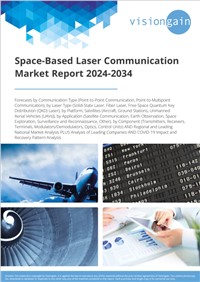The Space-Based Laser Communication Market Report 2024-2034: This report will prove invaluable to leading firms striving for new revenue pockets if they wish to better understand the industry and its underlying dynamics. It will be useful for companies that would like to expand into different industries or to expand their existing operations in a new region.
Increasing Demand for High-Speed Data Transmission
The growing demand for high-speed data transmission in space-based applications, such as Earth observation, remote sensing, and scientific missions, is a major driver for the adoption of laser communication technology. Traditional radio frequency (RF) communication systems face limitations in bandwidth and data rates, especially for large volumes of data. Space-based laser communication offers significantly higher data transmission speeds, enabling faster and more efficient transfer of large datasets between satellites, spacecraft, and ground stations. For example, NASA’s Lunar Laser Communication Demonstration (LLCD) achieved data transmission rates of up to 622 megabits per second (Mbps) from lunar orbit to Earth, demonstrating the potential of laser communication for high-speed space missions.
High Development and Deployment Costs Hinder Market Growth
One of the significant challenges impeding the growth of the space-based laser communication market is the high development and deployment costs associated with implementing advanced laser communication systems. The intricate technology involved in designing and manufacturing laser communication components, such as transmitters, receivers, and control units, demands substantial financial investments. For instance, the research, development, and testing of cutting-edge laser communication systems may require extensive resources, skilled personnel, and state-of-the-art facilities. This financial barrier can be particularly restrictive for smaller space organizations or emerging startups aiming to enter the market. As a result, the high cost of development and deployment acts as a deterrent to widespread adoption, limiting market expansion.
What Questions Should You Ask before Buying a Market Research Report?
- How is the space-based laser communication market evolving?
- What is driving and restraining the space-based laser communication market?
- How will each space-based laser communication submarket segment grow over the forecast period and how much revenue will these submarkets account for in 2034?
- How will the market shares for each space-based laser communication submarket develop from 2024 to 2034?
- What will be the main driver for the overall market from 2024 to 2034?
- Will leading space-based laser communication markets broadly follow the macroeconomic dynamics, or will individual national markets outperform others?
- How will the market shares of the national markets change by 2034 and which geographical region will lead the market in 2034?
- Who are the leading players and what are their prospects over the forecast period?
- What are the space-based laser communication projects for these leading companies?
- How will the industry evolve during the period between 2024 and 2034? What are the implications of space-based laser communication projects taking place now and over the next 10 years?
- Is there a greater need for product commercialisation to further scale the space-based laser communication market?
- Where is the space-based laser communication market heading and how can you ensure you are at the forefront of the market?
- What are the best investment options for new product and service lines?
- What are the key prospects for moving companies into a new growth path and C-suite?
- Our 416-page report provides 132 tables and 190 charts/graphs exclusively to you.
- The report highlights key lucrative areas in the industry so you can target them – NOW.
- It contains in-depth analysis of global, regional and national sales and growth.
- It highlights for you the key successful trends, changes and revenue projections made by your competitors.
This report tells you TODAY how the space-based laser communication market will develop in the next 10 years, and in line with the variations in COVID-19 economic recession and bounce. This market is more critical now than at any point over the last 10 years.
Forecasts to 2034 and other analyses reveal commercial prospects
- In addition to revenue forecasting to 2034, our new study provides you with recent results, growth rates, and market shares.
- You will find original analyses, with business outlooks and developments.
- Discover qualitative analyses (including market dynamics, drivers, opportunities, restraints and challenges), cost structure, impact of rising space-based laser communication prices and recent developments.
This report includes data analysis and invaluable insight into how COVID-19 will affect the industry and your company. Four COVID-19 recovery patterns and their impact, namely, “V”, “L”, “W” and “U” are discussed in this report.
Segments Covered in the Report
Market Segment by Communication Type
- Point-to-Point Communication
- Point-to-Multipoint Communication
- Solid-State Laser
- Fiber Laser
- Free-Space Quantum Key Distribution (QKD) Laser
- Satellites
- Aircraft
- Ground Stations
- Unmanned Aerial Vehicles (UAVs)
- Satellite Communication
- Earth Observation
- Space Exploration
- Surveillance and Reconnaissance
- Other Applications
- Transmitters
- Receivers
- Terminals
- Modulators/Demodulators
- Optics
- Control Units




